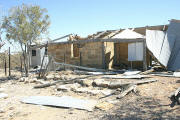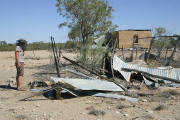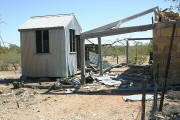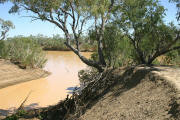|
The faces in the
photograph are changing
And I can’t believe he looks so much like me
For it’s been ten long years today
Since I left for Old Cork Station
Saying I won’t be back til the droving’s done
The words of this relatively contemporary bush ballad by Hugh
McDonald are among the most evocative of the many songs written
about the time and the place and the people who pioneered the
outback. If you’ve heard the song, how could you go anywhere near
Winton, Qld, and not want to drive out to Old Cork Station to just
reflect and wonder and dream?
In April 2007 we had thought of camping at Diamantina National
Park, but travelling alone as we were, and restricted to UHF and
CDMA (not very useful at all in Central and Western Queensland),
we opted just to drive out to Old Cork Station from Winton. We
dutifully left details with a Caravan Park manager (policeman not
home, and useful whiteboard outside the station door lacked a
marker) and headed off early for the 320km round trip via the
Kennedy Developmental Road and the unsealed road immediately to
the east of the Diamantina River. The road to Old Cork Station is
not signposted off the Kennedy Developmental Road but the turn off
is right where the Hema Queensland’s Outback map says it should be
at the 55km mark.
The road crosses smooth flood plains, stony creek beds (dry) that
illustrate the reason why this is called the Channel Country,
gibber plains, occasional jump-ups, and numerous small water
‘drains’. There are several stations along the way, and even
though we didn’t see another vehicle all day and we could enjoy
the sense of remoteness, we obviously weren’t isolated. The road
really presents little difficulty, although some of the creek
entries and exits do require the ground clearance benefit of a
4WD, but . . .wonder at the history of an upturned Morris Minor
about 50 metres off the track.
It is all ‘outback’. How fortunate we are to have people who can
use words to paint the pictures of the landscape, but at the same
time, how lucky we are to be able to experience it and to feel a
part of it – and you do. While the history of our indigenous
brothers and sisters ties them to and identifies them with the
land, we think that we white fellas can also belong to the ‘wide
brown land’.
At the T-junction with the road from Lark Quarry there is a sign to
Old Cork Station (4km). Shortly after there is a fork in the road;
the right fork goes to Boulia and crosses the Diamantina, the left
fork takes you to Old Cork Station, which at that point is less
than two kilometres on the right and visible from the road. It is
on the eastern bank of the Diamantina, and at the junction of the
Mayne River and the Diamantina.
From descriptions we had read from other travellers, we were
expecting much more of a ruin than is the case. As our photos
show, some of the walls still stand along with an outbuilding, and
a windmill on the riverbank. On the day that we were there it was
35 degrees and windy (but the flies still managed to stick on and
find their way into any opening), and dusty (well, it would be
wouldn’t it!). There are no facilities at Old Cork Station, but
there is river frontage camping and you could be assured of having
plenty of space for yourself.
The property is reported as having been first settled in the 1870s,
and finally abandoned as a homestead for property farm workers in
the 1980s. Material available from the Information Centre at
Winton suggests that with changes in ownership, records of Old
Cork Station have been lost. You can try to imagine what it might
have been like living at Old Cork Station year in and year out,
through flood and summer heat, through good years and bad, but
such imaginings can never summon up the reality – “for the years
have surely gone like the drays from Old Cork Station”. Despite
that, and the heat and the flies, how good it is to be able to
kick the real and imagined traces of what remains at places like
Old Cork Station, and to think about how much the pioneer settlers
and drovers shaped the character and culture of Australia.
For those who
really enjoy reading into history, the following website has a
project report 'Old Cork Station Conservation Plan' and this
provides an excellent background to the history (and perhaps the
future) of Old Cork Station.
www.thomblake.com.au/projects/?cat=3
|






|